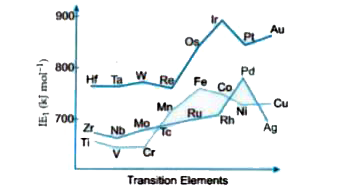How would you account for the irregular variation of ionisation enthalpies (first and second) in the first series of the transition elements?
First ionisation enthalpy : As we move from left to right, it is expected in general that the first ionisation enthalpy should show an increasing trend. However, the trend is irregular because removal of the electron alters the relative energies of 4s and 3d orbitals. Thus, there is a reorgani-sation energy accompanying ionisation. This results into the release of exchange energy which increases as the number of electrons increases in the d-orbitals and also from the transference of s-electrons into d-orbitals. Cr has low first ionisation energy because loss of one electron gives stable electronic configuration (3d5). Zn has very high ionisation energy because electron is removed from 4s orbital of the stable configuration (3d104s2). Half-filled and fully filled configurations are more stable than others.
Second ionisation enthalpy : After the loss of one electron, the removel of second electron becomes much more difficult. Hence, second ionisation enthalpies are much higher and in general increase from left to right. However, Cr and Cu show much higher values because the second electron has to be removed from the stable configurations of Cr+(3d5) and Cu+(3d10).
Topper's Solved these Questions
- THE D-AND F-BLOCK ELEMENTS BOOK - U-LIKE SERIESCHAPTER - THE D-AND F-BLOCK ELEMENTS EXERCISE - NCERT TEXTBOOK EXERCISES
32 Videos
- THE D-AND F-BLOCK ELEMENTS BOOK - U-LIKE SERIESCHAPTER - THE D-AND F-BLOCK ELEMENTS EXERCISE - CASE BASED/SOURCE-BASED INTEGRATED QUESTIONS
15 Videos
- SURFACE CHEMISTRYBOOK - U-LIKE SERIESCHAPTER - SURFACE CHEMISTRYEXERCISE - SELF ASSESSMENT TEST ( SECTION A)
7 Videos
- THE P-BLOCK ELEMENTS BOOK - U-LIKE SERIESCHAPTER - THE P-BLOCK ELEMENTS EXERCISE - SELF ASSESSMENT TEST ( SECTION A)
7 Videos
Similar Questions
Knowledge Check
The first ionisation energies of the elements of the transition series.
AIncreases as the atomic number increasesBDecreases as the atomic number increasesCDo not show any change as the addition of electrons takes place in the inner (n−1) d-orbitals.DNone of these
How would you account for the irregular of ionisation enthalpies (first) in the first series of the transition elements?
View Solution(i) Which of the first row transition metal exhibit +7 oxidation state? (ii) How would you account for the irregular variation of 1st and 2nd ionisation enthalpies in the 1st series of transition elements ? (iii) What are interstitial compounds ? (iv) Give two uses of potassium permanganate.
View SolutionAssign a reason for each of the following observation :
(i) The transition metals are hard and have high melting and boiling points
(ii) The ionisation enthalpies (first and second) in the first series of the transition elements are found to vary irregularly
View SolutionAssing a reason for each of the following observation :
(i) The transition metals (with the exception of Zn, Cd and Hg) are hard and have high melting and boiling points
(ii) The ionisation enthalpies (first and second) in the first series of the transition elements are found to vary irregularly
View Solution(a) Write balanced equations to represent what happens when
(i) Cu2+ is treated with KI.
(ii) Acidified potassium dichromate solution is reacted with iron (II) solution (ionic equation).
(b) (i) The figure given below illustrates the first ionisation enthalpies of first, second and third series of transition elements. Answer the questions that follow :

Which series amongst the first, second and third series of transition elements have the highest first ionisation enthalpy and why ?
(ii) Separation of lanthanoid elements is difficult. Explain.
(iii) Sm2+,Eu2+ and Yb2+ ions in solution are good reducing agents but an aqueous solution of Ce4+ is a good oxidising agent. Why?
View SolutionHow will you account for the following : (i) All scandium salt are white.
(ii) The first ionisation enthalpy of the 5d transition elements are higher than those of 3d and 4d transition elements in respective group.
View SolutionThe first ionisation energies of the elements of the transition series.
View Solution
